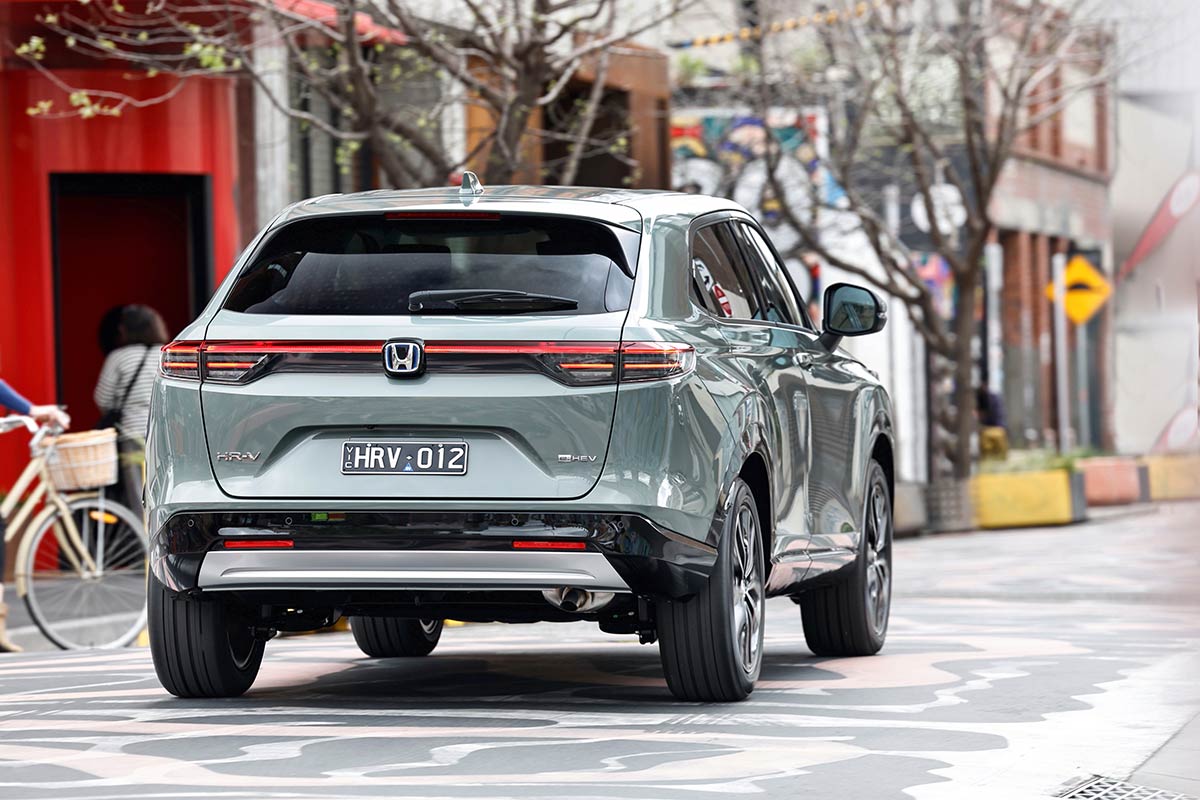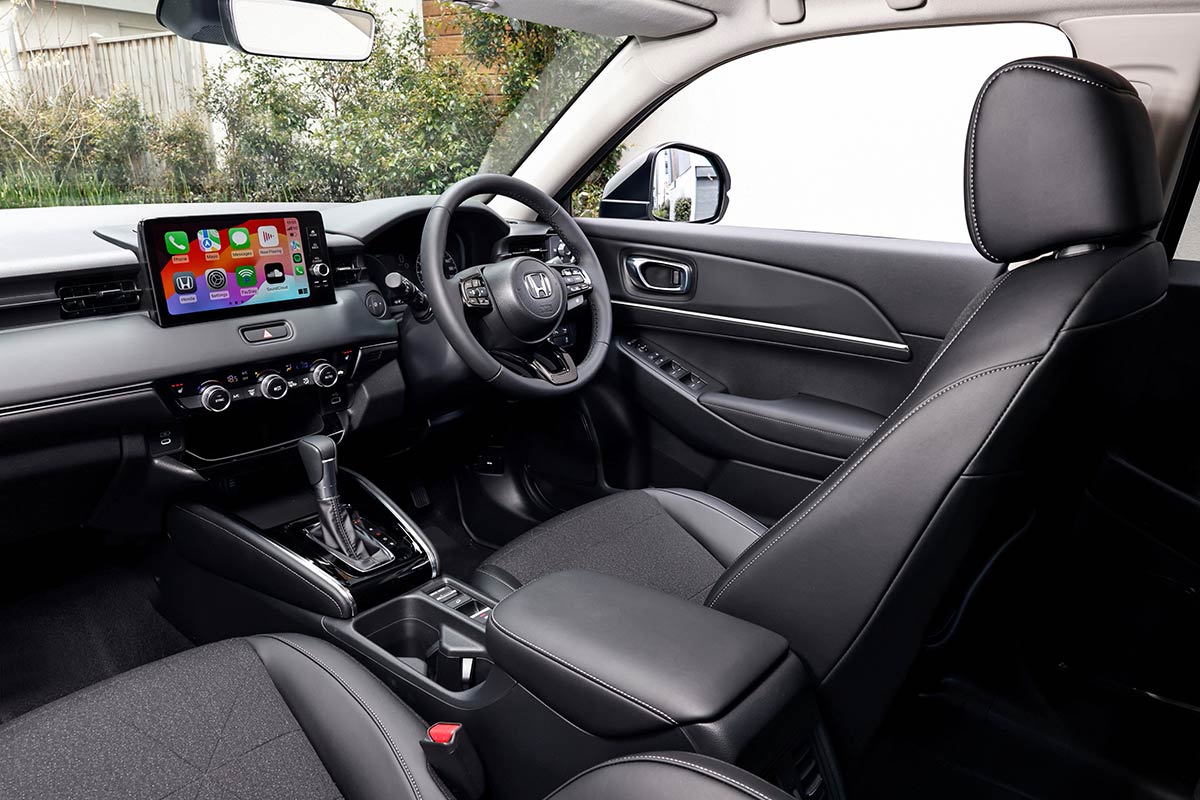
— Kris Ashton
The original Honda HR-V was a pioneer of the compact SUV segment, offering a smaller alternative to the Honda CR-V (which was itself a response to the SUV progenitor, Toyota’s RAV4). The HR-V has never been a sales chart topper in Australia and currently finds itself around the middle of the small SUV pack. Earlier this year, Honda gave its HR-V line-up a mid-cycle refresh and added a more affordable hybrid trim, e:HEV X, which slips between the petrol-only base model and the existing e:HEV L. Will this price cut make the e:HEV attractive to buyers on a budget?
The Honda HR-V range retains a petrol-only variant, the Vi X, for $34,900 before on-road costs. Above it now are two hybrid grades: the new e:HEV X (starting at $39,900) and the e:HEV L (for $42,900). This puts the HR-V in a sort of grey area between its fellow small SUVs and the lower end of the mid-sized SUV market. Potential hybrid small SUV competitors range from the Chery Tiggo 4 HEV ($27,990) up to the Hyundai Kona Hybrid (starting at $36,700) and Toyota Corolla Cross hybrid (from $37,440).
A point worth considering is that Honda employs a fixed-price agency model on its vehicles in Australia, so unlike many of those rivals, there is no wriggle room on the HR-V's recommended retail price.
By 2025 standards the HR-V e:HEV L (our test vehicle) has a conservative interior, with a predominantly black and dark-grey colour palette, traditional gear shifter, and modest central touchscreen. Soft-touch surfaces are more numerous than first impressions suggest and even the hard plastics seem to be good quality. The smooth leather steering wheel is pleasing to the touch and only the cloth seat upholstery suggests a nod to cost considerations.
The seats themselves are spacious and well bolstered, if lacking some padding in the bases, and there’s a general sense of roominess up front. Niceties on offer are two cup holders, one USB-A and one USB-C port, two useful storage cubbies fore of the gear shifter, and a small but useable space in the armrest. In the e:HEV X and L, seat heaters for driver and passenger give an extra luxury touch on those winter mornings.
Switching to the rear means an encounter with Honda’s annoying door handles integrated behind the C-pillar, a hangover from the ‘form over function’ trend that gripped car makers for a while. Once inside you find only two rear seats and two speakers. The fold-down armrest has two drink holders and an there’s an additional drink holder incorporated into each door. Further catering for odds-and-ends storage are pockets in the back of the front seats (on the e:HEV X and up) and a small receptacle below the centre console. The Vi X and e:HEV X must make do with two USB ports and no rear air con vents, while the e:HEV L gets two vents and four USB connections.
Leg, head, and foot room are very good by small SUV standards, although the seats are rather flat and not particularly supportive. The cargo area is larger than meets the eye, with a full metre between the wheel arches and 770mm between the floor and the top of the boot aperture, although the lid’s acute slope means clearance drops to a mere 450mm at the boot lip. The hybrid electrics consume underfloor space, so a puncture repair kit subs in for a spare wheel on all models. A powered tailgate with variable height function and automatic locking button adds convenience in e:HEV X grade and above.



Standard issue gear on the base model Vi X includes 18-inch alloy wheels, keyless entry and start, seven-inch central touchscreen and digital speedo, DAB+ radio, Google Assistant, wireless Apple CarPlay and Android auto, a four-speaker sound system, single-zone climate control, walk-away locking system, and dusk-sensing headlights.
The new e:HEV X grade adds an adaptive high-beam function, leather appointments to the seat upholstery, regenerative braking with paddle shifters, reversing sensors and a multi-angle reversing camera, satellite navigation, six-speaker sound system, and some cosmetic accoutrements.
Move up to e:HEV L and the standard features include dual zone climate control, heated and remotely retractable door mirrors, heated front seats, auto up/down on all windows, an auto-dimming review mirror, remote opening power windows, rear air con vents, hands-free tailgate operation, rear spoiler, black upholstery, water dispersing glass, and a heated steering wheel.
The four-star ANCAP safety rating awarded in 2022 still applies to this updated HR-V range. It has dual frontal, side chest-protecting and side head-protecting (curtain) airbags, but no centre airbag. According to the ANCAP report, the HR-V fell short of five stars for child occupant protection and safety assistance. “A weak head protection score was recorded for the 10-year-old child in the side impact test, and both occupancy detection for rear seating positions and driver fatigue monitoring are not available.”
Providing go for the HR-V Vi X is a 1.5-litre petrol four-cylinder engine mated to a CVT that produces 89kW and 145Nm. The hybrid models have the same engine matched to an electric continuously variable transmission (e-CVT), bumping up output to 96kW and 253Nm.
The two drivetrains develop their power in decidedly different ways, with the hybrids’ e-motor providing maximum torque from zero revs while the petrol-only engine doesn’t arrive at peak torque until 4300rpm. Both need quite a few revs to hit peak power, the hybrids at 4000rpm and the petrol engine a screamy 6600rpm.
Strange to say, the gear shifter in the HR-V feels a bit last decade in both its appearance and action. It’s a small thing, perhaps, but it gives the vehicle a budget feel from the outset that it could do without.
Ergonomics are pleasing overall – it’s much like piloting a high-riding Honda Civic – and the six-speaker sound system in the hybrid HR-Vs provides surprisingly good volume and clarity.
The hybrid drivetrain doesn’t quite have the pickup and acceleration the 253Nm on the spec sheet might suggest, but power delivery is smooth and progressive and only when you really drop your foot does the petrol engine take over in a raucous and thrashy fanfare of revs.
The hybrid HR-Vs weigh in at just under 1400kg, not bad for an SUV, and driving dynamics are sound all-round, with Macpherson struts up front and a rear torsion beam leading to excellent bump absorption and competent handling with plenty of road feel.
Even without putting the hybrid transmission in B (regenerative engine braking mode) we achieved fuel consumption of 5.0L/100km over a week’s driving, not far above the claimed combined figure of 4.3L/100km. Expect substantially higher returns from the petrol-only model, which has a claimed combined figure of 6.2L/100km.
The updated HR-V remains basic, but in a good way. Where so many of its competitors are now a circus of digital functions and haranguing active safety features, the HR-V provides calm, composed, well-built motoring with enough luxuries to make life comfortable. But even though the e:HEV X’s retail price subverts the $40k psychological barrier, the number of small and mid-sized SUVs available for a similar price means it will likely have an uphill battle winning over consumers on performance and bang for buck.